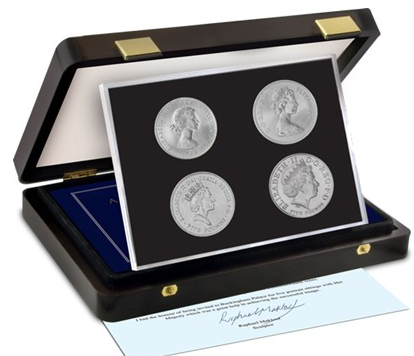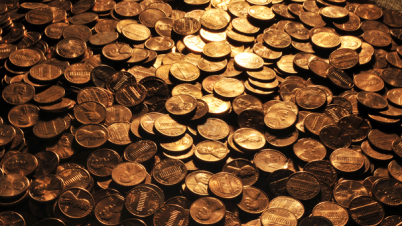Blog Home
Portraits of a Queen – the changing face of Britain’s coinage
Discover a little of the history behind the Queen’s effigy and vote for your favourite portrait.
As well as the 60th Coronation Anniversary, 2013 marks the 60th Anniversary of the Queen’s coinage.
The first Queen Elizabeth II coins were struck in 1953 and since then four different effigies adorned our coins.

1953 – 1967: Mary Gillick
The first coins of Queen Elizabeth’s reign bore Mary Gillick’s portrait of the young Queen, engraved especially for the new coins.
Her uncrowned portrait of the Queen is still used on the Maundy Money distributed each year by Her Majesty.
With the upcoming decimilisation, it was decided to refresh the Queen’s portrait with Arnold Machin’s new sculpture of the Queen. Commissioned in 1964, it first appeared in 1968 on the new 5p and 10p coins. A version of the design with tiara was also introduced on stamps in 1967 and remains to this day.

1985 – 1997: Raphael Maklouf
In creating his new effigy of Her Majesty, Raphael Maklouf aimed “to create a symbol, regal and ageless”.
His “couped” portrait depicts Queen Elizabeth II wearing the royal diadem favoured by her on the way to and from the State Opening of Parliament.
 1998 – current: Ian Rank-Broadley FRBS
1998 – current: Ian Rank-Broadley FRBS
The current Queen’s head on our coinage was designed in 1997 by Ian Rank-Broadley. Created to fill the full circle of the coin, its larger size was a deliberate response to the smaller 5p and 10p coins in circulation. A noticeably more mature portrayal of Her Majesty, Rank-Broadley aimed to show the Queen with “poise and bearing”.
You can own all four Portraits on original UK Crowns.
Click here for more info about the Portraits of the Queen 4-coin set
Why you should be Checking your Change
I expect that, like me, you were brought up to “check your change”. But it has never meant more than now.
Last year, the Royal Mint launched twenty-nine 50p coins into circulation, one for each of the Olympic disciplines. The result: a nation suddenly keen to check the coins in their pocket, hoping to build a complete collection.
In 20 years in the coin business, it was the very first time I had seen people of all ages genuinely interested by the coins in their change.
But the story should not stop with the Olympic 50p coins.
In fact the Royal Mint has been varying £1 coin designs since the coin was very first issued 30 years ago. Remarkably the 50p first saw a commemorative design in 1973, before they became a regular feature of the UK’s coinage during the 1990s. Similarly, £2 coins were used for commemorative coins as early as 1986, well before the current bi-metallic coin, which went into circulation in 1997, with its first commemorative design being released in 1999 for the Rugby World Cup.
The only collection that will cost you nothing
 Of course the joy of change collecting is that it is totally free. Simply keep an eye on the coins in your change and very quickly you’ll own an historic collection of some the UK’s finest coin designs.
Of course the joy of change collecting is that it is totally free. Simply keep an eye on the coins in your change and very quickly you’ll own an historic collection of some the UK’s finest coin designs.
But now it is even easier to collect the coins in your pocket with the launch of www.changechecker.org. This completely FREE site is available for mobiles, tablets and PC to help you collect your pocket change wherever you are.
Simply identify your coin by denomination and year to keep track of whether you already own it or not. Plus, if it’s a spare, you can quickly and easily find someone to swap your coin with. All without spending a penny (or any other denomination come to that).
Click here to visit www.changechecker.org.
Discover more about Change Checker with your 90 second guide.
“Penny not at top of agenda” – President Obama joins the debate
The man responsible for the world’s biggest economy blamed too many more pressing issues when questioned on why the US is still spending millions minting its penny when other countries have got rid of it.
But during the recent online Q & A, President Barack Obama did give his strongest hint yet that it might be time for America’s lowest value coin – which costs 2.4 cents to produce and circulate – to go once and for all.
Drop the penny and save a mint?
In 2009, the US Government lost nearly £20m minting its one-cent coins. That figure had trebled to almost £60m just two years later. At a time of global recession, many argue that ditching the penny would be an obvious cost-cutting measure. Like many others around the world, the UK included, the US penny can’t even buy itself.
Not a top priority
But is it quite as simple as that? Obama may be President of the world’s most powerful nation but even he needs legislation from Congress who, not surprisingly, has other more important things to do. And should the penny go, the five cent Nickel coin would be used more and that costs nearly five times more than the penny to put into circulation at 11.2 cents.
The end of the Canadian penny
As regular readers of this blog will know, should the bill ever go ahead, the US would be the latest in a long line of countries to eliminate its smallest denomination coin. Its North American neighbour stopped its production of the penny in January after more than 150 years.
But Americans it seems are just as sentimental as we Brits are about holding onto a part of our numismatic heritage – despite the fact we can do very little with our pennies but save them for a very rainy day …




